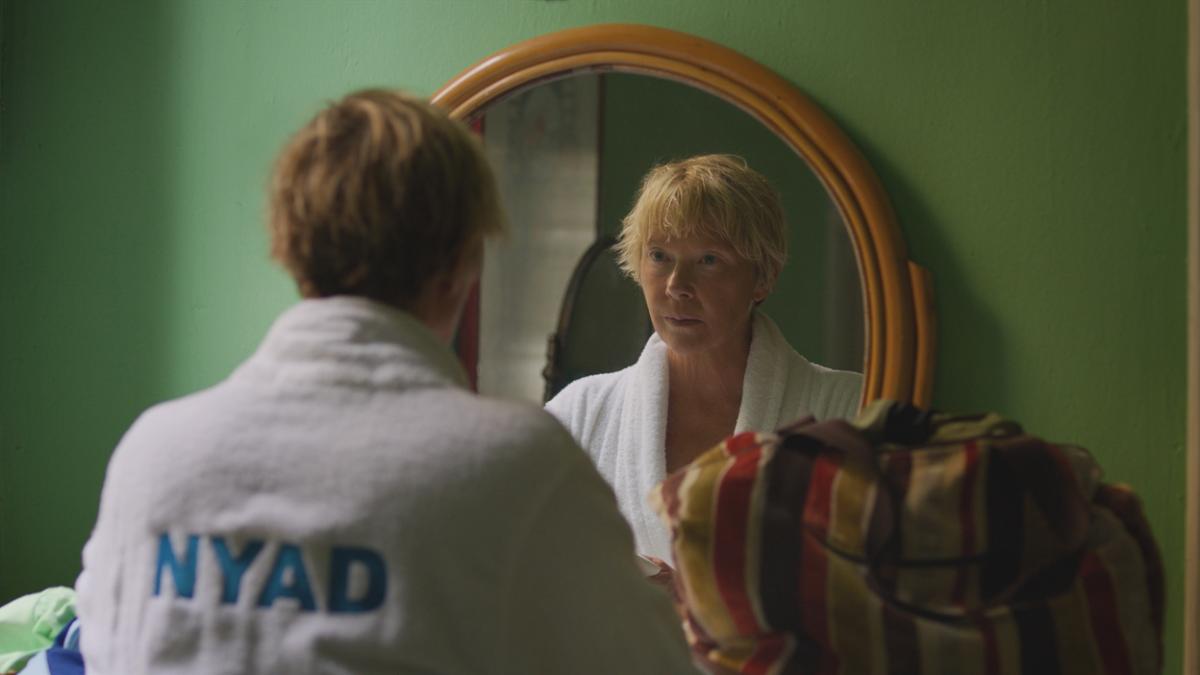
Based on the Nyad trailer, I made the assumption—and I suspect you did too—that Annette Bening and Jodie Foster were playing life partners, perhaps even spouses. I got it half right. They are life partners, but not of the romantic kind. Yes, they tried dating once back in the day—it didn’t take. Instead, they’ve been best friends for decades, the kind of best friends who know what the other is thinking without exchanging a word and can even read between the lines of what is said. (For example, when Bening’s Diana Nyad says she doesn’t want a surprise party for her 60th birthday, Foster’s Bonnie Stoll knows that means she actually does want one.) They love each other, they get on each other’s nerves. They have a casual physical intimacy. They fight, they make up—and have an easy, if prickly, rapport. Bonnie is particularly irked by Diana’s self-obsession, her tendency to self-mythologize. She interrupts Diana when she holds court at parties, sharing stories of her life of adventure, basically admonishing, “They’ve heard enough.”
But what a life of adventure it has been. As the film begins, Diana holds all sorts of records for long-distance swimming: Longest swim by a female. Longest swim without a wetsuit or a protective shark cage. Fastest swim around Manhattan. And so on.
She’s been retired from swimming for 30 years, spending her time as a television and radio correspondent (she has one of those gold ABC Wide World of Sports jackets hanging in her closet), writer, and motivational speaker.
But she’s in a funk. She comes across the phrase, “What is your plan to do with your one wild and precious life” and repeats it to Bonnie.
“Mary Oliver,” Bonnie says.
“You know her?” Nyad responds.
“It’s famous,” Bonnie says, somewhat derisively. (See? Prickly.)
But Diana is haunted by the phrase. She’s already done a lot with her own wild and precious life, but she wants to do more. Specifically, there’s some unfinished business involving a swim from Havana to Key West—110 miles and 60 hours of swimming. She failed the last time she tried it, in 1978. But she wants to give it another go. And she wants Bonnie to be her coach.
Bonnie says no at first—it’s madness, Diana is too old, too out of practice—but eventually succumbs. It’s hard to say no to Diana. And Bonnie is secretly proud to be part of her friend’s historic journey.
So they begin. They train. They get a crew—a navigator (Rhys Ifans), an expert in sharks, another expert in jellyfish, an on-board medic, a captain, sponsors (Secret deodorant!).
And we watch Diana’s attempt to complete the 110 mile swim.
While the film, directed by extreme sports documentarians Jimmy Chin and Elizabeth Chai Vasarhelyi, is primarily about the relationship between Diana and Bonnie, it’s also very much about long distance swimming—and how insanely grueling it is. If you attempt such an improbable endeavor, you will need to shit in the water. You will need to eat through a tube. You will begin to hallucinate. (Bonnie instructs the crew to go with it). Your face will become chapped and burnt and your body will become bloated. You will lose all sense of time and space. You will be exhausted to the point of inertia (at one point, Diana just flops around the waves, like a buoy). And, oh yeah, you might get eaten by a shark or stung by a poisonous jellyfish. Are we having fun yet?
As Diana, Bening gives a full-bodied performance, emphasis on body. The actress, who’s now 65, looks great—fit and lithe and nimble. But she also looks, well, like a woman in her 60s. She has wrinkles and sun spots. It’s a cliché, but there’s not a speck of vanity in this performance. Diana—and Bening—projects strength and vitality, but she also looks godawful sometimes as she fights mightily against both Father Time and the elements (it doesn’t help when she’s forced to wear a face mask to protect herself from jellyfish that could scare off Michael Myers). But even her burnt, water-logged body is a kind of badge of honor. It inspires. It made me want to put on a bathing suit and go to the Y for a swim (laps, not miles, mind you).
Foster has the less showy part, but she’s great here, too. And frankly, it’s just a pleasure to see her act again. (I know she’s done some television recently, but I haven’t seen her since 2013’s Elysium—the less said about that the better.) There’s a gutsiness to Foster—that thing she does where she juts out her chin and stares at you defiantly—that masks a deep well of vulnerability. Lots of actresses do the tough-yet-vulnerable thing. But Foster does it explicitly. The more fiercely she sets her face, the closer we know she is to crumpling into tears.
And she cries a lot here. Bonnie has a special burden. She’s all too aware that if she pulls Diana from the water—in the middle of a dangerous rain storm, for example—her friend will resent her for life. But she also knows that the decision—to keep swimming, risking Diana’s life, or remove her, resulting in failure—is always in her hands. It’s a heavy weight to bear.
There’s a bit of a back story thrown in, involving Nyad’s sexual abuse at the hands of a high school swim coach, that doesn’t add much to the film. I understand why they used it—it’s a huge part of Nyad’s life story. But the suggestion that this abuse (and the fact that the coach never saw consequences for his actions) somehow fuels Diana’s quest for greatness never convinces.
Still, Nyad really works. It works as a rousing sports film, the literal embodiment of that old Wide World of Sports motto: “The thrill of victory and the agony of defeat.” It works as a film about teamwork—not just Diana and Bonnie, but the entire crew, especially Ifan’s craggy, stubborn navigator, who gives as good as he gets (and comes to love both Diana and Bonnie, in his own withholding way). But mostly it’s a film about female friendship, about a friend who will love you at your best and your worst—and who will truly bask in your triumphs. It is a love story. Just not the kind I was expecting.
